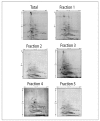Red blood cell subpopulations in freshly drawn blood: application of proteomics and metabolomics to a decades-long biological issue
- PMID: 22871816
- PMCID: PMC3557492
- DOI: 10.2450/2012.0164-11
Red blood cell subpopulations in freshly drawn blood: application of proteomics and metabolomics to a decades-long biological issue
Abstract
Background: It has long been known that red blood cells comprise various subpopulations, which can be separated through Percoll density gradients.
Materials and methods: In this study, we performed integrated flow cytometry, proteomic and metabolomic analyses on five distinct red blood cell subpopulations obtained by Percoll density gradient separation of freshly drawn leucocyte-depleted erythrocyte concentrates. The relation of density gradient fractions to cell age was confirmed through band 4.1a/4.1b assays.
Results: We observed a decrease in size and increase in cell rugosity in older (denser) populations. Metabolomic analysis of fraction 5 (the oldest population) showed a decrease of glycolytic metabolism and of anti-oxidant defence-related mechanisms, resulting in decreased activation of the pentose phosphate pathway, less accumulation of NADPH and reduced glutathione and increased levels of oxidized glutathione. These observations strengthen conclusions about the role of oxidative stress in erythrocyte ageing in vivo, in analogy with results of recent in vitro studies. On the other hand, no substantial proteomic differences were observed among fractions. This result was partly explained by intrinsic technical limitations of the two-dimensional gel electrophoresis approach and the probable clearance from the bloodstream of erythrocytes with membrane protein alterations. Since this clearance effect is not present in vitro (in blood bank conditions), proteomic studies have shown substantial membrane lesions in ageing red blood cells in vitro.
Conclusion: This analysis shows that the three main red blood cell subpopulations, accounting for over 92% of the total RBC, are rather homogeneous soon after withdrawal. Major age-related alterations in vivo probably affect enzyme activities through post-translational mechanisms rather than through changes in the overall proteomic profile of RBC.
Figures




Similar articles
-
Time-course investigation of SAGM-stored leukocyte-filtered red bood cell concentrates: from metabolism to proteomics.Haematologica. 2012 Jan;97(1):107-15. doi: 10.3324/haematol.2011.051789. Epub 2011 Oct 11. Haematologica. 2012. PMID: 21993682 Free PMC article.
-
Alterations of red blood cell metabolome during cold liquid storage of erythrocyte concentrates in CPD-SAGM.J Proteomics. 2012 Dec 5;76 Spec No.:168-80. doi: 10.1016/j.jprot.2012.03.012. Epub 2012 Mar 20. J Proteomics. 2012. PMID: 22465715 Clinical Trial.
-
Quantifying dynamic range in red blood cell energetics: Evidence of progressive energy failure during storage.Transfusion. 2021 May;61(5):1586-1599. doi: 10.1111/trf.16395. Epub 2021 Apr 8. Transfusion. 2021. PMID: 33830505 Free PMC article.
-
An update on red blood cell storage lesions, as gleaned through biochemistry and omics technologies.Transfusion. 2015 Jan;55(1):205-19. doi: 10.1111/trf.12804. Epub 2014 Aug 6. Transfusion. 2015. PMID: 25130459 Review.
-
Purinergic control of red blood cell metabolism: novel strategies to improve red cell storage quality.Blood Transfus. 2017 Oct;15(6):535-542. doi: 10.2450/2017.0366-16. Epub 2017 Apr 12. Blood Transfus. 2017. PMID: 28488967 Free PMC article. Review.
Cited by
-
Red blood cell populations and membrane levels of peroxiredoxin 2 as candidate biomarkers to reveal blood doping.Blood Transfus. 2012 May;10 Suppl 2(Suppl 2):s71-7. doi: 10.2450/2012.011S. Blood Transfus. 2012. PMID: 22890272 Free PMC article.
-
Inductively-Coupled Plasma Mass Spectrometry-Novel Insights From an Old Technology Into Stressed Red Blood Cell Physiology.Front Physiol. 2022 Feb 7;13:828087. doi: 10.3389/fphys.2022.828087. eCollection 2022. Front Physiol. 2022. PMID: 35197866 Free PMC article.
-
The Multiple Facets of Iron Recycling.Genes (Basel). 2021 Aug 30;12(9):1364. doi: 10.3390/genes12091364. Genes (Basel). 2021. PMID: 34573346 Free PMC article. Review.
-
ZOOMICS: Comparative Metabolomics of Red Blood Cells From Guinea Pigs, Humans, and Non-human Primates During Refrigerated Storage for Up to 42 Days.Front Physiol. 2022 Mar 21;13:845347. doi: 10.3389/fphys.2022.845347. eCollection 2022. Front Physiol. 2022. PMID: 35388289 Free PMC article.
-
The Proteome of the Red Blood Cell: An Auspicious Source of New Insights into Membrane-Centered Regulation of Homeostasis.Proteomes. 2016 Nov 25;4(4):35. doi: 10.3390/proteomes4040035. Proteomes. 2016. PMID: 28248245 Free PMC article. Review.
References
-
- Bratosin D, Mazurier J, Tissier JP, et al. Cellular and molecular mechanisms of senescent erythrocyte phagocytosis by macrophages. A review. Biochimie. 1998;80:173–95. - PubMed
-
- Lutz HU, Fasler S, Stammler P, et al. Naturally occurring anti-band 3 antibodies and complement in phagocytosis of oxidatively-stressed and in clearance of senescent red cells. Blood Cells. 1988;14:175–203. - PubMed
-
- Schroit AJ, Madsen JW, Tanaka Y. In vivo recognition and clearance of red blood cells containing phosphatidylserine in their plasma membranes. J Biol Chem. 1985;260:5131–8. - PubMed
-
- Connor J, Pak CC, Schroit AJ. Exposure of phosphatidylserine in the outer leaflet of human red blood cells. Relationship to cell density, cell age, and clearance by mononuclear cells. J Biol Chem. 1994;269:2399–404. - PubMed
Publication types
MeSH terms
Substances
LinkOut - more resources
Full Text Sources
Other Literature Sources
